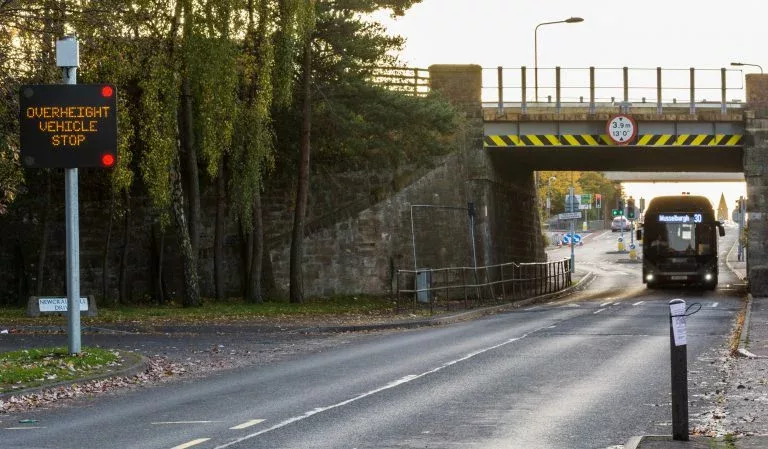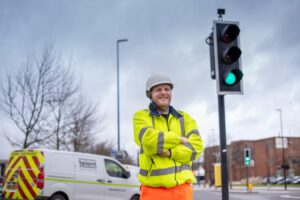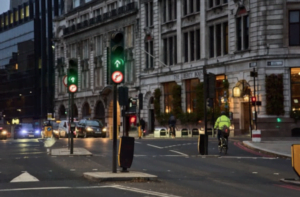News of more major bridge strikes in the last few months is a stark warning that the challenge hasn’t been solved yet.
A strike in Plymouth, Devon, recently caused four days of disruption for the local rail network, costing thousands of pounds and causing severe damage.
As a result, lorry drivers and haulage companies have been told to ‘take better care’ by Network Rail.
It said that about five railway bridges were hit by lorries a day nationally and the annual bill for “such careless driving comes in at around £20m”.
Mike Gallop, of Network Rail, said: “We are urging all lorry drivers and haulage companies to take better care, look out for the height warnings on all of our bridges, and take a second to think before taking a risk and causing disruption to so many people’s lives,” he told the BBC.
Elsewhere, last month the road and rail infrastructure in Mid Wales was gridlocked after a tipper truck hit a railway bridge in Machynlleth, Powys.
Motorists faced long diversions after the A470 was closed for several hours, while rail disruption continued for much of the day.
Just two weeks earlier rail passengers in the region had faced more delays after another bridge strike near Bow Street, near Aberystwyth.
In fact, a quick search on the internet will reveal several strikes in the last month alone.
HGV drivers could face losing their licences or being fined if they crash into bridges in the future. Licences could be revoked, and HGV operators served with six-figure bills as part of a plan to cut the number of hugely disruptive bridge strikes.
Network Rail’s statics show that 1,624 bridges were hit by vehicles — usually HGVs or buses — in the year to the end of March. This was more than four a day on average, despite a sharp drop in traffic during the period because of the pandemic.
The organisation has said it was keen to highlight that good practice guides have been developed in conjunction with our freight and passenger transport industry partners.
These are designed to raise the awareness of professional drivers and managers of transport companies to the risks and consequences of bridge strikes. They also give guidance to them on how they can be prevented. The four guides, available from the Department for Transport website, are as follows:
*Transport managers guide
*Professional drivers of passenger vehicles guide
*Guide for passenger vehicle operational staff
*Professional drivers’ guide
Network Rail’s response to a bridge strike is multi-faceted. It works with the police, highways authorities, hauliers and members of the public in order that the actions that we take are the safest for all those involved (including any potential rail or road traffic) and allow for the most efficient return to normal operating conditions.
The police consider a bridge strike to be a potentially critical incident. Working with police forces, Network Rail has developed police Bridge Strike Protocol – initial actions (PDF), which details the roles and responsibilities of the respective control offices when responding to a reported bridge strike.
The protocol is a framework of key actions to be undertaken by the police and Network Rail so that all those involved in the response to a bridge strike can work together in a consistent manner and achieve high levels of safety, while minimising delay to the operational railway and to road users.
The protocol response to a Bridge strike at a bridge carrying the railway over a road (PDF) has been developed in conjunction with highway and road authorities, police and fire and rescue organisations.
It provides guidance and advice to those involved in the response to a bridge strike at a bridge carrying the railway over a highway or road and details the actions necessary to maintain the safety of the railway and public highways and roads.
But guidance and even changing the law cannot guarantee total prevention of strikes. Use of more technology, alongside better planning and co-ordination could still help further, however.
Network Rail agrees. Sir Peter Hendy CBE, chair of Network Rail told Highways News: “Bridge strikes are an unwanted burden on our railway. They cause serious safety risks, hours of delays for rail passengers and drain public funds which should be used on upgrading and improving our network. We work closely with our industry partners, drivers and operators to tackle the problem – through education, engineering, enablement and enforcement – but more needs to be done. Technology has a key part to play in making bridge strikes a thing of the past and we welcome operators and industry partners taking proactive steps in this area. Network Rail has compiled data from every underline bridge that has been involved in a bridge strike since the year 2000. This information can be added to navigation and route planning tools to alert road users of an oncoming bridge so that they can take appropriate action.”
Although many of the bridges are owned by Network Rail, several also belong to road operators-mainly councils.
Drivers have often blamed inadequate signage and sat-nav systems not having information on low bridges to search. While it is true local authorities are not obliged to make public the height of their bridges, work is being done on the road network to help prevent bridge strikes.
Kevin Dentith, chairman of ADEPT’s National Bridges Group said local authorities where ‘working hard’ to prevent strikes whether that was putting up beams to protect the most vulnerable parts of the bridges such as the parapets or installing signage. “There are many examples of best practice and signage that is placed well before the bridge but often they are simply ignored.” In Devon, Mr Dentith’s own authority where he is Chief Engineer, he has installed CCTV near some frequently hit bridges. “The idea here is that it will act as a deterrent for drivers that simply think they can take a risk,” he added, “And evidence shows that it is working. While strikes haven’t been eliminated, they have been greatly reduced.” Mr Dentith said that it was a matter for the UK’s Bridge Strike Prevention Group to continue to work with industry to continue to reduce the number of strikes and undercover more technology that could help aid that. He also said further discussion was needed on whether all bridge heights should be made public to help provide better information to haulage companies and for sat-nav software programmes.
Technology already exists to help drivers. Infrastructure technology specialist Coeval is one company providing a solution. Its vehicle warning sign systems use sensors to constantly monitor traffic flow on approaches to the infrastructure, such as a gantry or bridge. This means it can identify an overheight vehicle in advance of it reaching the infrastructure that they are too high to pass through.
When an overheight vehicle is detected an intelligent LED sign illuminates, instructing the driver to take the nominated diversion, stop or turn back.
With this simple measure, Coeval’s OVD System directly addresses the issue of drivers not knowing the height of their vehicle. As well as the clear benefits of their responsive nature, the warning signs are robust, vandal resistant and visible in all conditions – an especially crucial benefit in the winter, where driver visibility can be a challenge. The road sign technology is fully customisable, so the message is bespoke to its location, providing specific instructions to the driver. The LED signage can be accessed locally or remotely when using the company’s Cloud Control Solution.
Richard Bevins, Managing Director of Coeval says: “It is important that all owners of bridges work together on continuing to not only raise the profile of the issues and consequences of strikes but strive to work to utilise better planning, co-ordination and technology to help eradicate bridge strikes.”
But weight can also be a problem. A study by The RAC Foundation found that more than 3,000 bridges in the UK are not fit to support the heaviest lorries, which can weigh up to 44 tonnes.
The physical infrastructure around the bridge location plays an important part in advising, informing, and enabling HGV drivers to avoid unsuitable bridges, with more effective warning road signage and improved turning areas, for example.
Coeval has designed technology solutions to help prevent incidents associated with ‘overweight vehicles’ and protect both the infrastructure and the user.
The Overweight Vehicle Detection System (OWVD) uses sensors to constantly monitor traffic flow on approaches to the infrastructure. By combining loop and axle classification it can identify an overweight vehicle in advance and display messages on intelligent LED signage to divert non-compliant vehicles, thereby protecting the infrastructure.





















